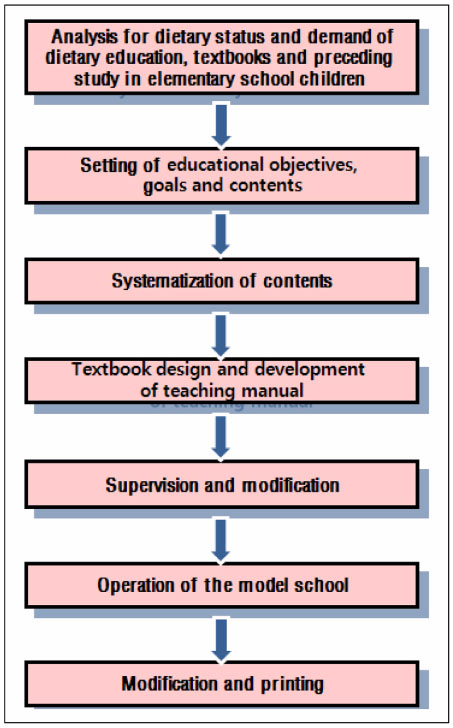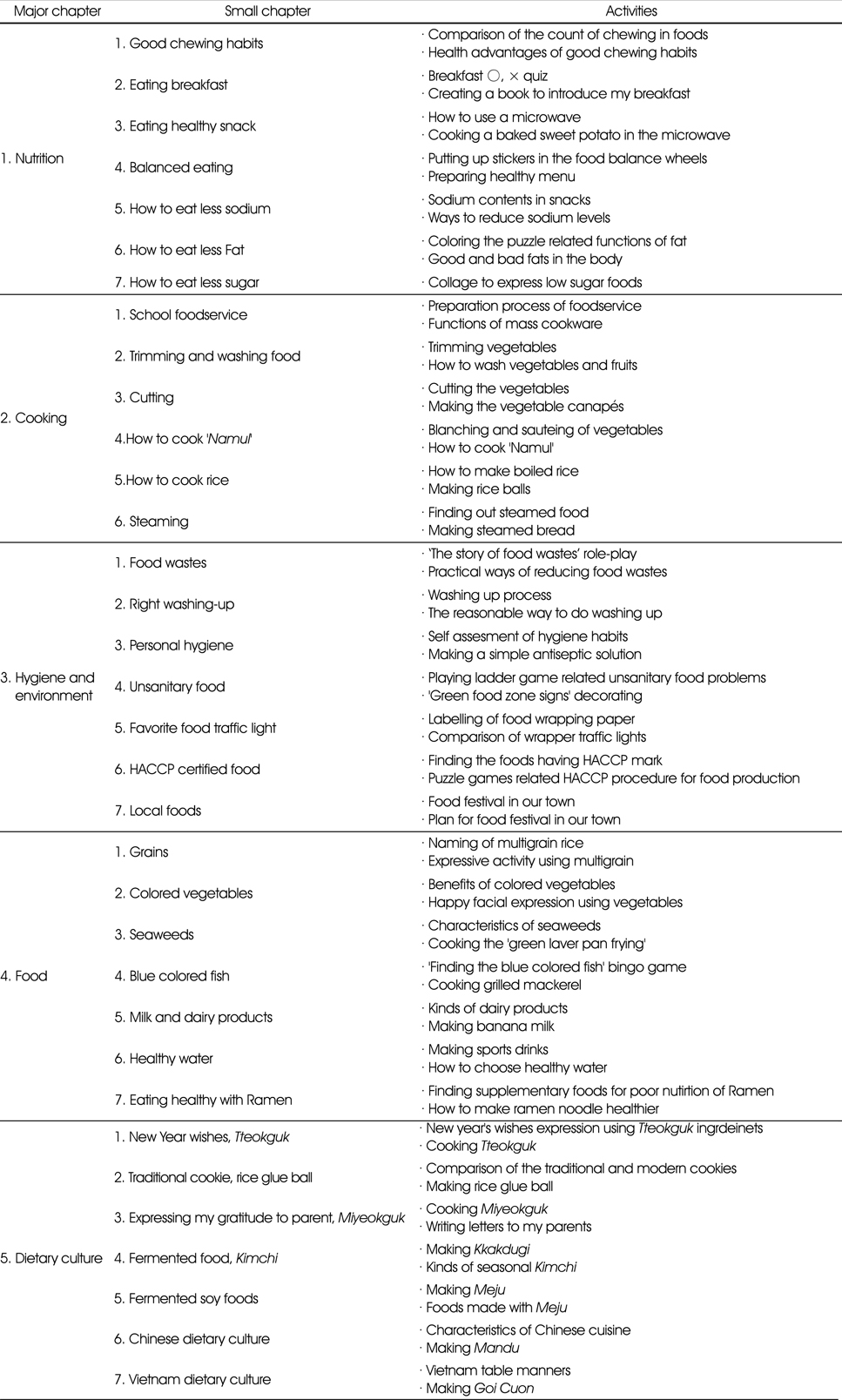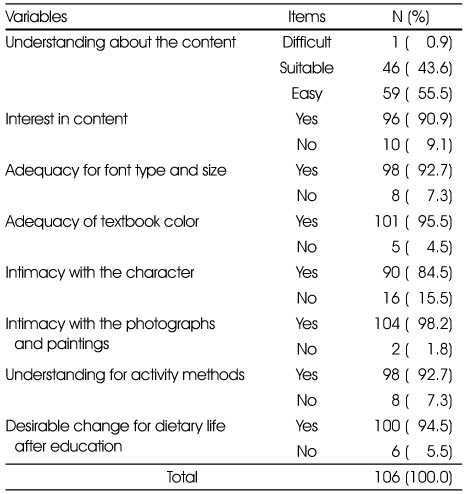References
1. Cheong HS, Lee JS. Study on nutrition education and perception of nutrition teachers and dietitians in Gyeongnam area. Korean J Food Cookery Sci 2012;28(3):229–240.
2. Cho MK, Lee KH, Lee KA, Lee SS, Kim YK, Her ES. Development of contents and textbooks for the education to reduce elementary students' natrium intake. Korean J Nutr 2009;42(6):567–576.
3. Choi EY. Development of nutritional education program for nutrition teacher in elementary school Seoul: Sookmyung Women's University press; 2005.
4. Her ES. Development of practical dietary education textbook and teaching manual in elementary school students. Korean J Community Nutr 2010;15(5):636–647.
5. Her ES. Eating behavior, nutrition knowledge and educational needs of the food and nutrition of elementary school students in the Gyeungnam province. Korean J Community Nutr 2013;18(1):11–24.
6. Chang SO, Lee OH, Lee KS. Intake of processed foods and the effects of nutrition label education in 5th grade children. J Korean Diet Assoc 2008;14(2):166–175.
7. Jeon SK. Educational meanings and effective practical plans of school dietary life education. J Korean Home Econ Educ Assoc 2010;22(1):117–135.
8. Jo MA. A study on dietary habits and development of teaching-learning curriculum of nutrition education for obese elementary school children Changwon: Changwon National University press; 2007.
9. Kim HH, Park YH, Shin EK, Shin KH, Bae IS, Lee YK. Students's and parents's perceptions of nutrition education in elementary schools. J Korean Soc Food Sci Nutr 2006;35(8):1016–1024.
10. Kim JH, Jeon SK. A study on the systematization of contents and textbook analysis for school dietary education in elementary school. J Korean Home Econ Assoc 2010;48(9):1–12.
11. Kim JY, Sim KH. The actual conditions and recognition of dietary life education in elementary school after execution of the dietary life education support act. Korean J Food Nutr 2011;24(3):295–305.
12. Kim JY, Sim KH. A survey on dietary education needs for implementing dietary education by teachers in elementary schools. Korean J Food Cookery Sci 2012;28(2):183–193.
13. Kim KA, Lee YK. The effect of nutrition education using animations on the nutrition knowledge, eating habits and food preferences of elementary school students. Korean J Community Nutr 2010;15(1):50–60.
14. Kim SH, Choi EH, Lee KE, Kwak TK. Effects of nutrition education on food waste reduction. J Korean Diet Assoc 2007;13(4):357–367.
15. Kim YH, Jang MR. A research on analysis of eating habits and textbook contents for efficient nutrition education of elementary school students in Gangneung city. J Korean Diet Assoc 2007;13(4):379–388.
16. Kim YK, Kim JY, Cha MH, Lee KA, Lee SS, Lee KH. Development of contents and textbook for the education to reduce elementary students' fat intake. Korean J Community Nutr 2009;14(2):158–167.
17. Korea Agency of Education, Promotion and Information Service in Food, Agriculture, Forestry and Fisheries. Available from
http://www.epis.or.kr 2013. cited 2013 March 14.
18. Kyeon YK. Application of practical nutrition education program for the improvement of dietary habits and attitudes of elementary students Seoul: Seoul National University press; 2006.
19. Lee KA. Activity-based nutrition education for elementary school students. J Korean J Nutr 2003;36(4):405–417.
20. Lee KH, Her ES, Woo TJ. Development of nutrition education textbook and teaching manual in elementary school. J Korean Diet Assoc 2005a;11(2):205–215.
21. Lee YM, Lee MJ, Kim SY. Effect of nutrition education through discretional activities in elementary school. J Korean Diet Assoc 2005b;11(3):331–340.
22. Ministry of Education, Science and Technology. 2007, 2009 revised curriculum 2013. cited 2013 March 14. Available from
http://cutis.mest.go.kr.
24. Ministry of Health and Welfare. Report on 2011 national health and nutrition survey 2012. cited 2013 March 13.
http://www.khidi.or.kr.
25. Park SD. Impact of self-concept promotion program on the learning attitude and sociability of lower graders in elementary school Cheonan: Baekseok University press; 2007.
26. The Korean Dietetic Association. Our food culture learning interestedly 2006. cited 2013 March 14. Available from
http://www.dietitian.or.kr.
27. Weiss EH, Kien CL. A synthesis of research on nutrition education at the elementary school level. J School Health 1987;57(1):8–11.
28. Yoon HJ, Yoon KS. Elementary school students' knowledge, behavior and request for education method associated with food safety. J Korean Diet Assoc 2007;13(2):169–182.
29. Yun JS, Lyu ES. Satisfaction and perception of nutrition education by elementary school students. J Korean Soc Food Sci Nutr 2012;41(9):1259–1264.






